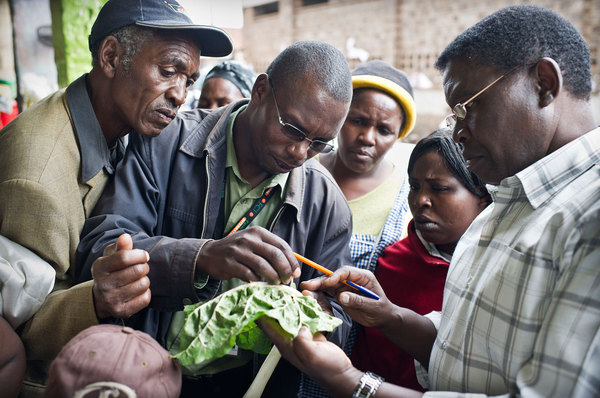Update: New Pest & Disease Records (2 Nov 11)
We’ve selected a few of the latest new geographic, host and species records for plant pests and diseases from CAB Abstracts. Click on the links to view the abstracts. Description of Bursaphelenchus kiyoharai n. sp. (Tylenchina: Aphelenchoididae) with remarks on the taxonomic framework of the Parasitaphelenchinae Rühm, 1956 and Aphelenchoidinae Fuchs, 1937. Kanzaki, N.; Maehara,…
Plant clinics begin in Cambodia
Plant clinics are being established in Cambodia for the first time. Phil Taylor from CABI UK met up with YC Low and Mei-Jean Sue from the CABI Malaysian office to train Cambodia’s first Plant doctors at the Royal University of Agriculture in Phnom Penh. They were joined by Vietnamese Plant doctors from the Southern Horticultural…
Boosting Yields with Banana Compost
In Egypt a new ‘banana compost’ has been trialled with positive results. The compost increases crop yields whilst reducing water and fertiliser use. This new cultural method of crop management could soon be commercially produced to help Egyptian farmers Banana plants only fruit once in their lifetime and are normally burned by farmers afterwards to…
Update: Plant Health News (27 Oct 11)
Here’s a taste of some of the latest news stories about plant health: Finland: Colorado beetles could spend winter in fields Fresh Plaza, 25 October 2011 Kenya restricts banana seedling movements to contain disease FreshFruitPortal.com, 24 October 2011 Building capacity to overcome wheat rusts CIMMYT’s blog, 25 October 2011 Breakthrough for flood-tolerant crops Farmers Weekly, 21…
Improved understanding of Striga resistance in rice
A group of scientists from the Netherlands, UK and Africa have studied upland NERICA rice cultivars to identify those that exhibit multi-level striga resistance. In two separate research papers, the 18 NEw RICe for Africa (NERICA) cultivars and their parents were screened for pre- and post- attachment striga resistance. One particular cultivar NERICA 1 was…
Anti-Terror Measures Allow Pest Explosion
Since 9/11 the number of invasive pests and plant diseases managing to slip into the USA has risen dramatically. Border checkpoints normally act as a first line of defence against these pests and diseases, however the increased emphasis on anti-terrorism measures has led to agricultural issues being ignored. This costs the USA a staggering $120…
Update: New Pest & Disease Records (19 Oct 11)
We’ve selected a few of the latest new geographic, host and species records for plant pests and diseases from CAB Abstracts. Click on the links to view the abstracts. First report of blue mold caused by Penicillium oxalicum in tomato (Solanum lycopersicum) in Mexico. Picos-Munoz, P. A.; Garcia-Estrada, R. S.; Carrillo-Fasio, J. A.; Leon-Felix, J.;…
Is citrus greening coming your way?
Mexico is the latest to succumb to the inevitable spread and establishment of huanglongbing (HLB) – the devastating disease of citrus crops. Mexican authorities in the states of Jalisco, Michoacán and Colima have warned growers that HLB – otherwise known as citrus greening – is here to stay. HLB was first detected in Mexico in…
Information Diffusion Key to Pest Management
A recent study has found that integrated pest management programs can experience significant lags in their implementation due to slow ‘information diffusion’ within farmer communities. Cooperation between farmers in developing countries was found to be key to ensure the successful coordinated implementation of such programs. Integrated pest management (IPM) programs are biological approaches to dealing…

